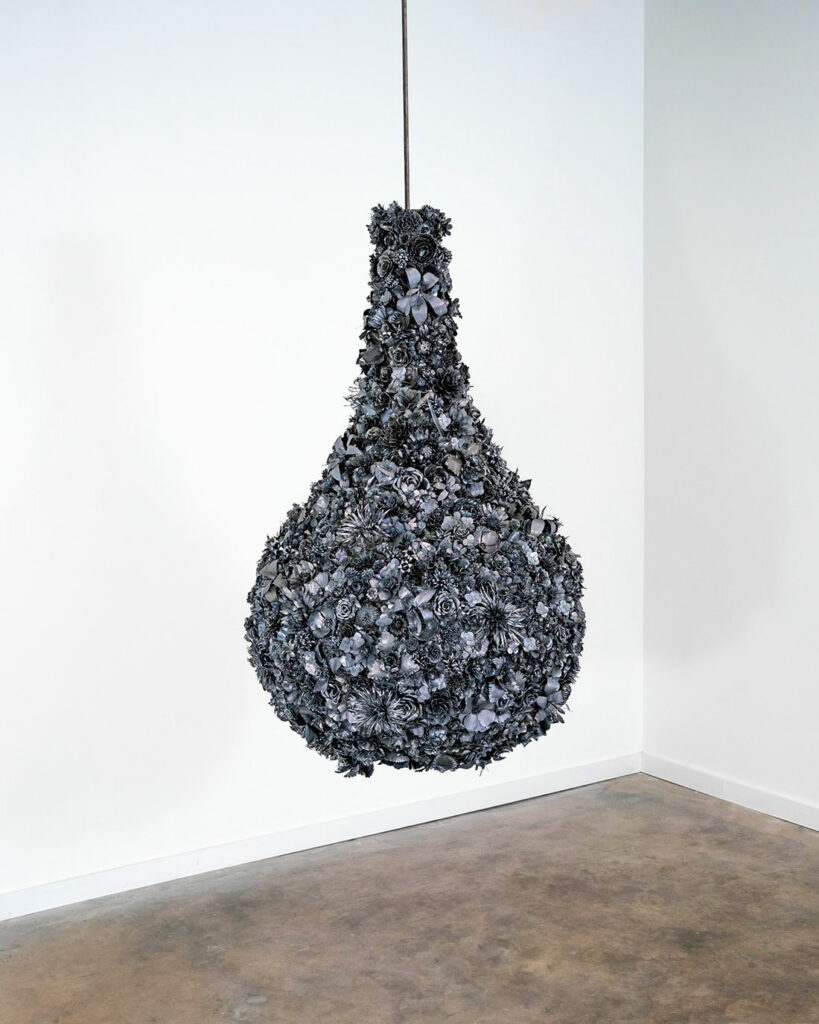Exquisite and subversive, the exhibition “Onodera & Pearse: Contrasts and Correlations” pairs the works of two artists who contemplate symbolic, emotional and cultural aspects of metal objects associated with women. Masako Onodera, a professor at the University of Wisconsin-Stout, and Mary Hallam Pearse, an associate professor at the Lamar Dodd School of Art at the University of Georgia, share backgrounds in craft and interests in embracing sculptural applications of metal and paper. Currently on view at the Athens Institute for Contemporary Art (ATHICA), the exhibition explores themes of memory, loss and the fragility of the feminine.
“Contrasts and Correlations” was curated by ATHICA director Lauren Fancher, who had been closely following the development of Pearse’s intricate sculpture, “Full Bloom,” with a wish to one day present the jaw-dropping work in the gallery. After seeing Onodera’s delicate and mysterious work at the Haystack Mountain School of Crafts in Maine, Fancher felt inspired to invite the two artists to collaborate on an exhibition together.
Suspended from the ceiling in the center of the gallery, “Full Bloom” resembles a large wrecking ball or teardrop covered in hundreds of life-sized lead flowers. Pearse began creating the sculpture, which took roughly two years to complete, at the beginning of the COVID-19 pandemic. Unable to access the art school’s equipment and studio spaces, her students were challenged with finishing out the semester remotely, so she decided to assign herself the same task of creatively using materials around the home.

Pearse began by constructing paper flower models that could be digitally scanned and used as patterns by a Cricut machine capable of cutting through thin sheets of lead. Initially, she played with the idea of making a bouquet of lead flowers, but as social and political unrest grew as the pandemic went on, the project expanded in scope and size. This daily ritual of flower-making offered a grounding source of certainty during an unpredictable time.
At the core of “Full Bloom” is a contemplation on the paradoxical nature of lead intersecting with the symbolism of flowers. A malleable, abundant metal that has been commonly used for thousands of years, lead has a fraught history due to its extreme toxicity. Flowers, which are often given during times of celebration or as tokens of love, are just as often sent to the grieving as gestures of mourning, comfort or sympathy. Lead can be practical or deadly, depending on its application, and this dichotomy is echoed in the way flowers culturally mark life and death simultaneously.
“Full Bloom” begins to resemble a chandelier when hanging beside Onodera’s spectral “Party,” a sculptural work designed to recall a dinner table setting. Onodera became drawn to silver-plated household materials that were left abandoned and forgotten at antique stores, imagining the lives of people who owned, cherished and took care of these heirloom objects in the past. She created impressions of these objects using handmade paper to create both “Party” and “Ghost.” Each delicate piece of handmade paper rests on a piano wire, and the works become activated, eerily fluttering, as viewers move through the space nearby.

Onodera takes her unique approach a step further with “Time,” a whimsical wall-bound work that consists of two topsy-turvy, three-dimensional clusters of vintage tableware. Using a paper casting process in which paper is applied to the outside of objects with glue, then cut open and assembled, “Time” considers memory, history and the lifespan of these once precious objects.
While focusing on the artists’ distinctive sculpture-based work, “Contrasts and Correlations” also features several objects demonstrating their shared interest in ornamentation and jewelry making. Onodera’s lace-like necklace, “Elements,” was assembled from decorative embellishments cut off of silver-plated platters. Recognizing that these antique platters primarily serve as memories of people and rarely get to perform their originally intended purpose as tableware, Onodera gives them a new function as ornamentation.
Pearse’s “Collar” represents her ongoing exploration in pushing the limits of the lost wax casting method. She collects vintage waxes—shapes used in the jewelry industry to make multiples—and wax welds them together to create a new form. A mold is created around the waxes, the wax is melted out to leave a negative cavity, and the cavity is then injected with molten metal. The result, in the case of “Collar,” is an intricate web of little charms: a seahorse, wing, seashell, hand and other miscellaneous miniatures.
“Contrasts and Correlations” will remain on view at ATHICA through Feb. 11. ATHICA will then open its “2024 Members’ Showcase,” an annual exhibition spotlighting artists who support the nonprofit gallery through memberships, with a reception on Feb. 15 from 6–9 p.m. The exhibition will remain on view through Mar. 17, with a variety of music, comedy and theater events planned throughout its duration. Stay tuned to athica.org for event details.
Like what you just read? Support Flagpole by making a donation today. Every dollar you give helps fund our ongoing mission to provide Athens with quality, independent journalism.










